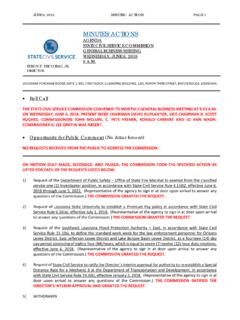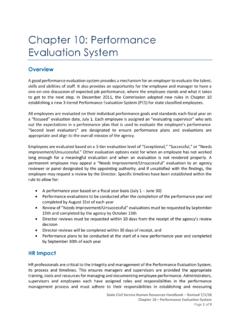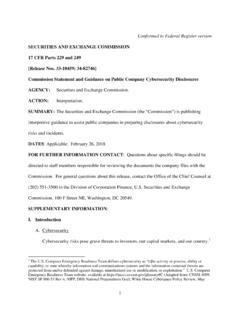Transcription of JOB AIDS AND RESOURCES SCS Guidelines for Preparing ...
1 JOB AIDS AND RESOURCES . SCS Guidelines for Preparing Affirmative Action Plans TABLE OF CONTENTS. I. purpose 2. II. Scope 2. III. Retention 2. IV. Agencies Required to Submit an AAP or an EEO Policy 2. A. Agencies With Fewer Than 50 Employees 2. B. Agencies With 50 or More Employees 2. V. Dates 3. VI. Parts of an AAP 4. A. Cover Page 4. B. Equal Employment Opportunity Policy 5. C. Designation of Responsibility 5. D. Organizational Profile 5. - Workforce Analysis 5. - Organizational Display 5. E. Comparison of Incumbency to Availability 6. 1. Job Group Analysis 6. 2. Placement of Incumbents in Job Groups 7. 3. Availability 7. 4. Comparing Incumbents and Availability 8. F. Summary of Personnel Activity 9. 1. Hires 9. 2. Terminations 9. 3. Promotions and Upward Reallocations 9. 4. Applicant Flow 9. G. History of Comparisons and Action Steps 10. VII. Presentation 10. VIII. Definitions and Lists 11.
2 A. EEO-4 Job Categories 11. B. EEO-6 Job Categories 12. C. Ethnic Groups 14. D. Example of Job Divisions 14. IX. DSCS Checklist 16. X. Forms 17. JOB AIDS AND RESOURCES . SCS Guidelines for Preparing Affirmative Action Plans Page 2 of 17. I. purpose . An Affirmative Action Plan is a written document that guides you on the path of Equal Employment Opportunity. It begins with a commitment to Equal Employment Opportunity and assigns responsibility for Equal Employment Opportunity to the people who can make it happen. Then it looks at the females and minorities in your workforce by structure (Who reports to whom?) and by jobs (Who is in what kinds of jobs?). After you see who is working in your jobs, you can compare them to the people who are available to work in those jobs. Your Affirmative Action plan also shows you how people have been affected by the personnel actions you have taken. You will see who has applied to work for you and who has been hired, terminated, and promoted.
3 Finally, your Affirmative Action Plan looks at your past and present workforce compared to the workforce you could have (Availability), and lists the steps that have gotten your workforce closer to the available workforce and the steps you will take for continued Equal Employment Opportunity. Your Affirmative Action Plan shows you where you are, where you have been, and where you could be. It is a tool that puts your past and present in front of you to let you determine the best course for your future. It shows you how well you are living up to your commitment to Equal Employment Opportunity, and it lets you create your own path to more complete Equal Employment Opportunity. II. SCOPE. These Guidelines address Federal AAP requirements. They do not necessarily tell you how to fulfill any other requirements and complying with them does not relieve you of any other obligations. III. RETENTION.
4 The AAP should be retained for at least two years. IV. AGENCIES REQUIRED TO SUBMIT AN AAP OR AN EEO POLICY. A. Agencies With Fewer Than 50 Employees Non-Executive Branch agencies with fewer than 50 employees (classified and unclassified combined) are not required to prepare a full AAP but must have an Equal Employment Opportunity Policy, as set forth below. That policy must be updated when appropriate, signed by the Statutory Appointing Authority, and sent to this Department by January 1 of each year. B. Agencies With 50 or More Employees Every Department in the Executive Branch and every other state agency with more than 50 employees (classified and unclassified combined) at any time during a year must have an AAP in place, update it at least annually, and provide to the SCS Compliance and Audit Division for review during the agency's Compliance Audit. Every employee of the Department or Agency must be included in an AAP even Executive Branch employees who work in a facility or office with fewer than 50 employees.
5 Board and JOB AIDS AND RESOURCES . SCS Guidelines for Preparing Affirmative Action Plans Page 3 of 17. Commission Members who are appointed by the Governor or through another method beyond the control of the Department or Agency need not be counted or included. Each Executive Department may have one or more AAP's. Each Department may choose to prepare a single AAP that includes all of its employees or separate AAP's for individual offices, institutions, or facilities. For example, LDH may have one AAP that includes all LDH employees, or it may have a Primary AAP, . which would include the Secretary's Office and maybe the Office of Management and Finance, a separate AAP for each Program Office (Office of Public Health, Office of Mental Health, ), and separate AAP's for each Development Center and other unit (Licensing Boards, for example). The employees of each Office, Developmental Center, or other unit with fewer than 50 employees must be included in an AAP either the Primary AAP or the unit's AAP.
6 To decide whether your Department should have one or more AAP's, look at the personnel function. Consider how free the units are to act without approval. If the units have some degree of autonomy in hiring, firing, and other personnel activities, separate AAP's may be appropriate. If the units cannot take personnel actions without approval, separate AAP's are probably not appropriate. If separate AAP's are appropriate, you may choose to send one AAP that actually combines several AAP's. For example, the Department of Corrections/Corrections Services may submit an AAP that includes separate AAP's for Headquarters and for each Correctional Facility. If the Department has one EEO Policy and if Responsibilities are Designated to the same positions at each facility, those sections need not be repeated in each AAP. Each Department's Primary AAP must include a list of all Personnel Areas (for ISIS Departments) or Business Units (for some People Soft Departments) in the Department and indicate which AAP includes each Personnel Area or Business Unit.
7 V. DATES. An AAP analyzes workforce data from the past year, and describes action steps planned for the future. The data analysis in an AAP looks at personnel activity during a chosen twelve-month period. Based on the analysis of personnel activity during that past twelve-month period, the agency makes plans for how recruiting, hiring, etc. will be done during the next twelve months. The completed AAP must be submitted to the Department of State Civil Service within three months after the end of the data analysis period. For example, an agency may choose to use September 1, 2001 August 31, 2002 as the data analysis period. In this case, the data used in the AAP will reflect personnel activity from September 1, 2001, to August 31, 2002. The employee counts used in the AAP will be based on the employees in service on August 31, 2002. The action steps described in the AAP will address future personnel activities from September 1, 2002 to August 31, 2003.
8 The AAP will be due at Civil Service by December 1, 2002. Example: Data Dates: September 1, 2001 August 31, 2002. Action Steps Dates: September 1, 2002 August 31, 2003. Deadline for Submittal: December 1, 2002. JOB AIDS AND RESOURCES . SCS Guidelines for Preparing Affirmative Action Plans Page 4 of 17. Each agency chooses its AAP dates. When choosing, consider the availability of both data and personnel. If you know that your office is audited at a certain time every year, set your dates so that you will not be working on the AAP during that time. If you work at a University that hires many new employees at the beginning of each semester, set your dates so that you will not have to work on the AAP during those peak hiring periods. To request a change your AAP dates, submit your current and your proposed AAP dates to the Department of Civil Service prior to your current due date. VI. PARTS OF AN AAP.
9 You are only required to prepare and send the items that are listed and described below. If you are required to submit more information to the OFCCP or anyone else, you may send us a copy of the AAP. that you send them, as long as you send us everything that we require. Cover Page Table of Contents EEO Policy Designation of Responsibility Organizational Profile Comparison of Incumbency to Availability Summary of Personnel Activity History of Comparisons and Action Steps A. Cover Page The Cover Page must include: 1. The Organization's name and prior name if it changed in the last five years 2. Mailing Address (including Box or street address and zip code). 3. Data Year 4. AAP Year 5. The Preparer's name typed and signed and typed title 6. The EEO Coordinator's name typed and signed and typed title Indicate if this is the same person as the preparer 7. Statutory Appointing Authority's name typed and signed and typed title Clearly indicate any title (Dr.)
10 , Mr., Mrs., ) in the typed name 8. The following statement signed by the Statutory Appointing Authority: I have read this Affirmative Action Plan and will ensure that all necessary and appropriate steps are taken to ensure that this agency does provide equal employment opportunity to all employees and applicants.. 9. Personnel Areas or Business Units a. For all AAP's: The names of all Personnel Areas or Business Units included in the AAP. You may use a separate page. b. For each Primary AAP: The names of all Personnel Areas or Business Units in the Department and which AAP includes each. You may use a separate page. Sample of Cover Page for Primary AAP. JOB AIDS AND RESOURCES . SCS Guidelines for Preparing Affirmative Action Plans Page 5 of 17. Sample of Cover Page for Non-Primary AAP. B. Equal Employment Opportunity Policy An Equal Employment Opportunity Policy clearly states a commitment to equal employment opportunity through merit selection in all employment actions.













